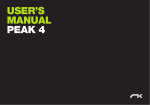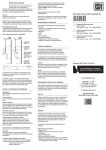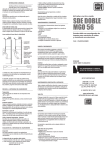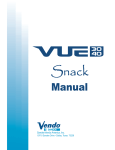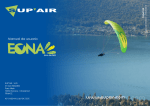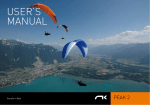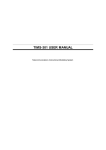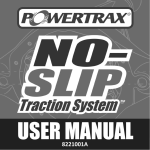Download Manual Artik P.indd
Transcript
USER’S MANUAL ARTIK P ARTIK P The adventurer NIVIUK Gliders ARTIK P WELCOME This manual offers all the necessary information that will familiarize you with the main characteristics of your new paraglider. Although this manual informs you about your glider, it does not offer the instruction requirements necessary for you to be able to pilot this type of wing. Flying instruction can only be taught at a paragliding school recognized by the Flying Federation of your country. We wish to welcome you to our team and thank you for the confidence that you have placed in a NIVIUK Glider. We would like to share with you the commitment, the passion and emotions of the Niviuk design team, which have resulted in the creation of the new ARTIK P. Niviuk are very proud of this new glider, carefully designed to bring you maximum pleasure whilst allowing you learn and progress. The legendary Artik design is now available in a lightweight version derived from and based on the best assets found in the previous models. For the XC, mountain or hike&fly pilots who want to explore new routes and need lightweight compact gear. We are confident that you will enjoy flying this wing and that you will soon understand the meaning of our slogan: “The importance of small details” This is the user’s manual that we recommend you to read in detail. The NIVIUK Team. Niviuk Gliders & Air Games sl C/ Del Ter 6, nave D 17165 La Cellera de Ter - Girona - Spain Tel. +34 972 42 28 78 Fax +34 972 42 00 86 [email protected] www.niviuk.com 2 USER’S MANUAL Nevertheless we remind you that it is important that you carefully read all the contents of the manual for your new ARTIK P. Severe injuries to the pilot can be the consequence of the misuse of this equipment. SUMMARY welcome2 4.3 USING THE ACCELERATOR 11 user’s manual 2 4.4 FLYING WITHOUT BRAKE LINES 11 1. CHARACTERISTICS 4 4.5 KNOTS IN FLIGHT 11 1.1 WHO IS IT DESIGNED FOR? 4 5. LOSING ALTITUDE 11 1.2 CERTIFICATION 4 5.1 EARS 11 1.3 IN-FLIGHT BEHAVIOUR 4 5.2 4B2 TECHNIQUE 12 1.4 ASSEMBLY, MATERIALS 4 5.3 B-LINE STALL 12 1.5 ELEMENTS, COMPONENTS 6 5.4 SPIRAL DIVE 13 2. UNPACKING AND ASSEMBLY 6 5.5 SLOW DESCENT TECHNIQUE 13 2.1 CHOOSE THE RIGHT LOCATION 6 6. SPECIAL METHODS 13 2.2 PROCEDURE 6 6.1 TOWING 13 2.3 ASSEMBLY OF THE HARNESS 6 6.2 ACROBATIC FLIGHT 13 2.4 TYPE OF HARNESS 6 7. CARE AND MAINTENANCE 14 2.5 ASSEMBLY OF THE ACCELERATOR 7 7.1 maintenance 14 7.2 STORAGE 14 2.6 INSPECTION AND WING INFLATION ON THE GROUND 7 7.3 CHECKS AND CONTROLS 14 2.7 ADJUSTING THE BRAKES 7 7.4 REPAIRS 14 3. THE FIRST FLIGHT 8 8. SAFETY AND RESPONSABILITY 14 3.1 CHOOSE THE RIGHT LOCATION 8 9. GUARANTEE 15 3.2 preparation 8 10. TECHNICAL DATA 16 3.3 FLIGHT PLAN 8 10.1 TECHNICAL DATA 16 3.4 PRE-FLIGHT CHECK LIST 8 10.2 MATERIALS DESCRIPTION 17 10.3 RISERS plan 18 3.5 WING INFLATION, CONTROL, AND TAKE-OFF 8 10.4 suspension PLAN 19 3.6 LANDING 8 10.5 DIMENSIONS ARTIK P 21 20 3.7 FOLDING INSTRUCTIONS 8 10.6 DIMENSIONS ARTIK P 23 20 4. IN FLIGHT 9 10.7 DIMENSIONS ARTIK P 25 21 4.1 Flying in TURBULENCE 9 10.8 DIMENSIONS ARTIK P 27 21 4.2 POSSIBLE CONFIGURATIONS 9 10.9 CERTIFICATION SPECIMEN TEST 22 3 1. CHARACTERISTICS all flying conditions, and behaving impeccably well in turbulence. 1.1 WHO IS IT DESIGNED FOR? 1.4 ASSEMBLY, MATERIALS The ARTIK P was designed for cross country, mountain or hike&fly pilots who want to explore new routes and need lightweight compact gear. The ARTIK P benefits from the latest technological advances used on other Niviuk gliders to enhance pilot comfort and improve the performance of the RAM, DRS, LI-NK light System and 3 line profile. 1.2 CERTIFICATION The ARTIK P has successfully passed the European EN/LTF certification. This test was carried out in the Swiss Air-Turquoise laboratories in Switzerland. All the commercially available sizes passed every required test with excellent results and the ARTIK P received the EN C / LTF C certifications for all sizes. The ARTIK P passed the essential load test of 8G’s without experiencing any problems. We recommend paying special attention to the flight test report made by the certification laboratory. The fligt test report indicates all necessary information to know and how the new paraglider will react during each tested manoeuvre. It is important to take understand that each size can have a different reaction with the same manoeuvre, and each wing size can behave differently depending on its all up weight. Check the certification results and figures on the last pages of this manual or www.niviuk.com 1.3 IN-FLIGHT BEHAVIOR With progressive, predictable and efficient handling the ARTIK P effectively reads the air mass rather easily, seeking out and coring thermals with efficiency and ease. It is an agile, light, predictable glider in 4 RAM.- The RAM AIR INTAKE technology presents an internal positioning for the air intakes, providing optimal and constent internal pressure as well as improving laminar air flow on the intrados. As a result, a significant turbulent air buffering takes place at the leading edge for better consistency across the speed range, and hence increasing performance with maximum safety. DRS.-The trailing edge was reinforced with small ribs, flattening it and spreading the pressure out evenly for better air-flow and less parasitic drag on this important part of the glider. The addition of these ribs gives exceptional handling (increased efficient when turning), more control and precision. 3LT.- Its powerful profile, a detailed internal architecture structure, and the use of high-tech strength materials make it possible to obtain a significant reduction of the combined suspension lines length, hence reducing the parasite drag amount and the weight of the glider to gain efficiency. LI-NK light System. – The LI-NK is an ultralight system made to connect the lines to the risers, and specially designed for mountain and lightweight gliders. It has a higher load bearing braking point than the traditional delta maillons without the weight. (Breaking strength LI-NK light System: 1300 kg / Maillón: 800 kg). The LI-NK light System is 25 times lighter and it is fitted with a locking system providing greater efficiency at maximum load. Dyneema braid stitched together with a locking strap. Notice: this system has not been proven or officially certified to connect the risers to the harness and/or the rescue parachute to the harness. 5.Push the looped end through the loop of the reinforced end (black tab) once more. 6.Push the reinforced end loop (black tab) through the looped end to secure them together. 7.Pull tight to secure the knot and connection. 8.Complete the operation by sliding the protective elastic sleeve over the entire assembly. The line plan on the ARTIK 4 combines Dyneema Liros and Vectram Cousinun. Both of them are unsheathed lines, which are slightly more exposed to the normal rigours and wear of our sport. It is strongly recommended for the lines to be thoroughly inspected by the pilot before each flight and ultimately checked by a specialized certified repair facility or Niviuk dealer after reaching one hundred (100) hours of flight. Keep in mind that we are dealing with high performance materials in need of systematic maintenance at regular intervals to keep them in top working conditions. The fabrics used have been carefully selected for their lightweight, UV standards and resilient properties. 1.Push the lines through the elastic sleeve, then the LI-NK light System through the lines and the riser. The reinforced end with the black tab should be located on the riser side first. 2.Push the upper looped end through the loop with the reinforced end where the black tab is located. 3.Continue with the procedure in a counterclockwise motion by pushing the looped end through the riser. 4.Push the looped end through the lines again following the same pattern. The entire process from Olivier’s computer thorough design work to manufacturing and final assembly must be flawless and done on a zero tolerance basis. Precision in all phases of work is central to delivering a perfect product to the pilot. An automated computerized lazer cutting plotter enables the various fabric panels to be cut with ultimate precision. The software not only guides the lazer cutter but prints the registration marks needed for assembly. It also numbers each individual piece of material. Machines take care of the initial phase before human handling of the pieces begins, so to eliminate possible problematic errors that could occur during this delicate procedure. The lines are semi-automatically manufactured and all the sewing is completed under the supervision of our specialists. The assembly 5 jigsaw puzzle is made easier as a result. We minimize the procedures while making quality control more efficient. All the various parts of the canopy are cut and assembled under the strict conditions induced by the automation of the whole process. All NIVIUK Gliders go through an extremely thorough and efficient final inspection. Every single glider line is measured once the final assembly has been completed Each wing is then individually inflated for the last visual inspection. Each glider is packaged following the maintenance and conservation instructions recommended for the advanced materials. NIVIUK Gliders are made of high quality materials for durability and best performance delivery to meet today’s market certification requirements. Material manufacturing information can be found on the last pages of this manual. you to carry out all the recommended steps required to check and inflate the ARTIK P. We recommend having professional supervision to conduct the entire procedure, and have it done as it should be. 2.2 PROCEDURE Take the paraglider out of the rucksack, open it and spread it open with the lines on top of the intrados. Position the wing as if you were to inflate it. Check the condition of the fabric and the lines, making sure there are no abnormalities. Check for the maillons attaching the lines to the risers to be fully closed and locked. Identify and if necessary disentangle the lines from the A, B and C risers, the brake lines and the corresponding risers. The lines must be free of entanglements and/or knots. 2.3 ASSEMBLY OF THE HARNESS 1.5 ELEMENTS, COMPONENTS The ARTIK P is delivered to its owner together with a series of components that, although not fundamental, do take an important part in the use, transport and storage of the paraglider: Correctly connect the risers to the harness karabiners. The risers and lines can not have any twists and must be in the right order. Check for the harness buckles to be securely locked. 2.4 TYPE OF HARNESS • A rucksack. •A small fabric repair kit with self-adhesive ripstop nylon (matching the wing’s color scheme) and replacement maillon blockers. 2. UNPACKING AND ASSEMBLY 2.1 CHOOSE THE RIGHT LOCATION We recommend unpacking and packing your wing on a school slope or a flat clear area, obstacle free and in low wind speed. Doing so will enable 6 The ARTIK P can be flown with most of the harnesses found on the market today, including cocoon type models. We strongly recommend adjusting the chest strap distance according the values used during the certification procedure. That distance will vary depending on the chosen harness model. Incorrect adjustment can seriously affect the glider’s flying behavior. Too wide a distance between the carabiners, may provide more feedback but could affect the overall stability of the glider. Too narrow a distance between the carabiners, would provide less feedback but also increase the risk of developing a twist in during a large collapse. Any chest strap adjustment other than the default certification setting would affect and alter the glider’s behavior. 2.5 AssemBlY oF THe ACCelerATor The acceleration mechanism of the ArTik p is activated by pushing with your feet on the accelerator bar supplied with the wing. The speed-bar must be properly installed and connected to the glider before your first flight. After installation, take into account that you will have to adjust the length of the accelerator lines for correct use. That distance will vary according to the length of the pilot’s legs! it is recommended to first check the speed system compatibility with the rest of the equipment. most paragliding schools will carry this type of gear. 2.6 iNspeCTioN ANd WiNG iNFlATioN oN THe GrouNd once your gear has been checked and made sure that the weather conditions are favorable, inflate your ArTik p as many times as necessary to become familiar with its behavior. The ArTik p inflates easily and smoothly. An over energetic inflation is not necessary to bring the wing overhead as it will climb gently with minimum pressure on the harness when moving forward. The inflation sequence can be made easier by using the A risers. do not pull on them; just accompany the natural rising arcing movement of the wing. once the wing has climbed overhead, simply apply the correct amount of brake pressure to keep the ArTik p above you. 2.7 AdJusTiNG THe BrAkes The length of the main brake lines is adjusted at the factory to the length established during certification. However, the length can be changed to adapt to the pilot’s own flying style. in any case, we recommend flying for a while using the default line factory settings before making any adjustment to them. it will enable you to become more familiar with the ArTik p and its unique flying characteristics. The speed-bar and riser connections to the speed-bar lines are made by nonslipping bowline knots. This configuration guaranties the same level of safety found when using metal crimped hooks while reducing the overall weight of the accelerator setup. if you then decide to change the length of the brake lines, untie the knot, slide the line through the brake link to the desired length, and strongly re-tie the knot. Qualified personnel should carry out this adjustment. You must ensure that this adjustment does not slow the glider down without pilot input. Both brake lines should be symmetrical and measure 7 the same length. The most recommended knots are the clove hitch or bowline knot. When changing the brakes length, it is necessary to check that they do not act when the accelerator is used. When accelerated, the glider rotates over the C risers, the trailing edge rises. The brake lines should be checked for proper adjustment, while taking this extra length into consideration. 3. THE FIRST FLIGHT 3.1 CHOOSE THE RIGHT LOCATION We recommend taking your first flight with your ARTIK P on a smooth slope (a school training hill) or at your usual flying area. 3.2 PREPARATION Repeat the procedures detailed in chapter 2 UNPACKING AND ASSEMBLY in order to prepare your equipment. 3.3 FLIGHT PLAN Make a flight plan before taking off to avoid possible flight problems later. 3.4 PRE-FLIGHT CHECK LIST Once ready, and before taking off, make a last visual equipment inspection to ensure that all is in order and good to go. Make sure the weather conditions are suited for your flying skills. 3.5 WING INFLATION, CONTROL, AND TAKE-OFF Smoothly and progressively inflate the wing (chapter 2.6 INSPECTION 8 AND WING INFLATION ON THE GROUND). The ARTIK P inflates easily and does not require excessive energy. No tendencies to overshoot, rendering the inflation sequence quite easy to achieve. Those characteristics enable the pilot to be in full control and give him/her enough time to decide whether or not to transit into the running phase toward a successful takeoff. Whenever the wind speed allows it, we recommend to do a reversed inflation. This technique enables the pilot to have a better view of the wing to make sure all is the way it should be before turning around and running down the slope. The ARTIK P is especially easy to control in this configuration and higher wind speeds. However, wind speeds up to 25 to 30 km/h are considered strong and extra consideration should be given on whether or not to takeoff. Pay particular attention to the wing layout on the ground. Choose an appropriate location for best wind direction. Display the paraglider symmetrically in a crescent-like shape facing upwind for a trouble free inflation before running and taking off. 3.6 LANDING Smoothly and progressively inflate the wing (chapter 2.6 INSPECTION AND WING INFLATION ON THE GROUND). The ARTIK P inflates easily and does not require excessive energy. No tendencies to overshoot, rendering the inflation sequence quite easy to achieve. Those characteristics enable the pilot to be in full control and give him/her enough time to decide whether or not to transit into the running phase toward a successful takeoff. Whenever the wind speed allows it, we recommend to do a reversed inflation. This technique enables the pilot to have a better view of the wing to make sure all is the way it should be before turning around and running down the slope. The ARTIK P is especially easy to control in this configuration and higher wind speeds. However, wind speeds up to 25 to 30 km/h are considered strong and extra consideration should be given on whether or not to takeoff. Pay particular attention to the wing layout on the ground. Choose an appropriate location for best wind direction. Display the paraglider symmetrically in a crescent-like shape facing upwind for a trouble free inflation before running and taking off. 3.7 FOLDING INSTRUCTIONS The ARTIK P has a complex leading and trailing edge, designed using a variety of different materials. For that reason, the use of a correct folding method is very important for extending the useful life of your paraglider. It should be folded in an accordion shape; with the leading edge reinforcements flat positioned one atop the other. This method will keep the profile in good shape without altering its form or performance. The wing should then be folded in three parts. It does not need to be tightly folded; doing so may damage the material and/or the lines. The N-Kare bag is an easy to use folding bag designed to assist you during the packing process. It can also be used as a surface base to protect the glider against damage. More information at: http://www.niviuk.com/accessories.asp?id=JNKQKNP4 4. IN FLIGHT 4.1 FLYING IN TURBULENCE The ARTIK P has an excellent profile design made to withstand various weather conditions, hence enabling the pilot to take advantage of its stability for greater piloting efficiency. It reacts admirably in passive flight mode, thus offering a high level of safety in turbulent conditions. Nonetheless, the pilot always has steer the wing and adapt his/her technique to the prevailing weather conditions as he/she is the ultimate safety factor. We recommend active piloting, the timely necessary fine adjustments to keep the wing in control. The pilot should stop braking to regain the necessary air speed after a correction is made. Do not maintain any correction using the toggles for longer than necessary or it would cause the wing to enter a dangerous flying configuration. Make prompt, precis yaw, pitch and roll adjustments when needed to re-establish normal air speed. 4.2 POSSIBLE CONFIGURATIONS To become familiar with those maneuvers, we recommend you to train under the supervision of a professional instructor within a school environment. Asymmetrical collapse In spite of the ARTIK P’s profile stability, strong turbulent air may cause the wing to collapse asymmetrically if the pilot was unable to predict the glider’s reactions in specific circumstances. When the wing is about to experience an asymmetric collapse the brake lines will transmit a loss of pressure to then be transferred to the pilot via the harness. To prevent the collapse from happening, pull the toggle corresponding to the compromised side of the wing. It will increase the incidence of the wing (angle of attack). If the collapse does happen the ARTIK P will not react violently, the turning tendency is gradual and easily controlled. Weightshift toward the flying and opposite side of the collapse to keep the wing on flying straight while applying a light brake pressure to that side if necessary to slow it down. The collapsed side of the wing should then recover and reopen by itself. If it does not, then pull the brake line toggle of the collapsed side decisively and quickly all the way down before bringing it back up immediately. You may have to repeat this pumping action to provoke the re-opening of the deflated glider side. Do not overbrake and slow down the flying side of the wing (risk of a stall for having too high an angle of attack). Once the collapsed side reopens, recenter your body under the wing to regain the default flying speed. 9 Symmetrical collapse In normal flying conditions and due to the ARTIK P’s design, asymmetrical collapses are unlikely to happen. The wing’s profile has great buffering abilities to deal with extreme incidence changes. A symmetrical collapse may occur in strong turbulent conditions, entering or exiting powerful thermals or when lacking experience using the accelerator/speed-bar with untimely inadequate input. Symmetrical collapses usually re-inflate without the glider turning, but a symmetrically applied quick braking action with a quick deep pump will accelerate the re-inflation if necessary. Release the brake lines immediately to return to default glider air speed. Negative spin A negative spin does not conform to the ARTIK P’s normal flight behavior. Certain circumstances however, may provoke this configuration such as trying to turn when flying at very low air speed deep in the brakes, and applying even more toggle pressure on one side). It is not easy to give any specific recommendation about this situation other than quickly restoring the wing’s default air speed and angle of attack by progressively reducing the tension on the brake lines. The normal wing reaction will be to have a lateral surge on the re-accelerated side with a rotation not greater than 360º before returning to default air speed and a straight flight path trajectory. Parachutal stall A parachutal stall takes place when the wing remains fully inflated but looses forward motion to then drop vertically at an accelerated rate. Instability and a lack of pressure on the brake lines sets in, although the canopy would appear to be correctly inflated. To regain normal air speed, release brake line tension symmetrically and push forward on the “A “ lines or weight-shift your body to any side WITHOUT PULLING ON THE BRAKE LINES. Deep stall The possibility of the ARTIK P falling into this configuration during normal flight is very unlikely. This could happen if you are flying at a very low 10 speed, whilst oversteering during a number of maneuvers and in turbulent conditions. The wing will enter a deep stall when reaching a point below minimum air speed by symmetrically pulling the brake lines. It is done by pulling the toggles all the way down and holding them in place. The glider will initially deflate and dive behind the pilot. Gravity will takeover with the pilot free falling for a second until the glider reposition itself overhead while rocking slightly, depending on how the maneuver was executed. When purposely initiating a stall, be positive and do not second guess the outcome for an instant. Do not release the brake lines when half way into the maneuver or it would cause the glider to violently surge forward with great energy in front of and passed the pilot. It is very important to apply a symmetrical strong brake pull to limit the surge and bring the wing back up. Lessen the brake tension as the glider rises to the overhead default flying angle of attack. If a symmetrical stall takes place, briefly and evenly pull the brake lines even if the wing is still ahead of you. Wing tangle A wing tangle may happen after an asymmetrical collapse, the end of the wing is trapped between the lines ( known as a Cravat ). This situation could rapidly cause the wing to spin on itself depending on the nature of the tangle. The corrective maneuvers to use are the same as those applied in the case of an asymmetrical collapse: control the turn/spin by applying tension on the opposite brake and counterweight shift opposite to the turn. Then locate the line that reaches the stabiliser that is trapped between the other lines. This line has a different colour and belongs to the outer lines of the “C” riser for sizes 23 and 25 and “B” riser for sizes 21 and 27. Pull on this line until it is tense as it should help undo the wing tangle. If ineffective, fly down to the nearest possible landing spot, control the trajectory with both counterweight shifting and use of the brake opposite to the tangled side. Be cautious when attempting to undo a tangle while flying near a mountainside or other paragliders; a loss of control of the intended flight path might become jeopardized and a subsequent collision could happen as result. Over handling Most flying problems are caused by wrong pilot input, to then degenerate into a cascade of unwanted and unpredicted series incidents. The ARTIK P was designed to recover by itself in most cases. Do no not try to over correct it! Generally speaking, the wing’s reactions will be proportional to the type, amount and duration of input sent by the pilot to the wing. Bringing the glider back to a normal flight configuration as soon as possible is the priority. 4.3 USING THE ACCELERATOR The profile of the ARTIK P was designed to fly stably throughout its entire speed range. It is useful to accelerate when flying in strong winds or in extreme descending air. When accelerating the wing, the profile becomes more sensitive to turbulence and closer to a possible frontal collapse. If a loss in internal wing pressure is felt, tension on the accelerator should be reduced to a minimum and a slight pull on the brake lines is recommended to increase the wing’s incidence angle. Remember to reestablish the flight speed after correcting the incidence. It is NOT recommended to accelerate near to the mountainside or in very turbulent conditions. If necessary you will have to constantly adjust the movements and pressure on the accelerator whilst constantly adjusting the pressure applied to the brake lines. This balance is considered to be “active piloting.” 4.4 FLYING WITHOUT BRAKE LINES If, for any reason at all, the ARTIK P’s brake lines become disabled in flight, piloting the wing with the “C” risers and weight shifting will become necessary. The C-lines steer easily because they are not under much tension, however you will need to be careful and not handle them too heavily to cause a stall or negative turn. The wing must be flown at full speed during the landing approach, and the “C” risers will have to be pulled symmetrically all the way down shortly before contact with the ground. This braking method is not as effective as using the brake lines, and hence will land with a higher ground speed. 4.5 KNOTS IN FLIGHT The best way to avoid these knots and tangles is to thoroughly inspect the lines as part of a systematic Pre-flight Check. If a knot is spotted during the running phase, immediately abort the running phase and stop. If inadvertently taking off with a knotted line, the glider drift will need to be compensated by weight-shifting to the opposite side of the wing and apply a slight brake pull to that side. Gently pulling the toggle line to see if the knot can be undone or try to locate the line with the knot. Try pulling the identified line to see if the knot can be undone. Beware of trying to clear a knotted line or untangle a line in flight. Do not pull too hard on the toggles for there will be an increased risk of stalling the wing or enter a negative turn. Before trying to remove a knot, make sure there are no pilots flying nearby, and never try these attempts close to the mountainside. If the knot is too tight and cannot be removed, carefully and safely fly to the nearest landing zone. The ARTIK P risers were designed without any adjustable, removable or variable device to prevent an incorrect use of the accelerator system. 11 5. LOSING ALTITUDE Knowledge of different descent techniques is important and could be extremely useful to have. The most adequate descent method will vary depending on any particular situation. We recommend learning these maneuvers within a competent school environment. 5.1 EARS Big ears is a moderate descent technique, achieving about –3 to –4 m/s and a ground speed reduction between 3 and 5 km/h. Effective piloting then becomes limited once the maneuver has been activated. The angle of incidence and wing loading also increases. Push on the accelerator/ speed-bar to restore the wing’s initial air speed and the angle of attack. To enter a “Big Ears” configuration, simultaneously pull on “4A2” lines and simultaneously, smoothly pull them outward and downward. The wingtips will fold in. Let go of the lines to reopen the wing tips to a default configuration. If they do not re-inflate, gently pull on one of the brake lines and then on the opposite one. We recommend inflating the wing tips asymmetrically, not to alter the angle of incidence, especially if you are flying near the ground or flying in turbulence. 5.2 4B2 TECHNIQUE On the new glider generation, using “Big Ears” can create a high degree of parasitic turbulence which can creates a significant loss of airspeed. When “Big Ears” are applied to high aspect ratio wings the wing tips tend to “flap” which also adds to the amount of unwanted turbulence. This new rapid descent technique was first discovered by our Niviuk team Pilots in 2009 while flying a competition prototype wings, which because of its line plan and high aspect ratio would not allow “Big Ears” to be applied. In fact, on 2 line wing profiles it has been often proven difficult to achieve. 12 For all these reasons, we advise the use of the 4B2 line descent technique. This technique ensures a rapid descent while maintaining forward air speed, and thus, eliminating the risk of a potential stall. WHAT TO DO? Locate the 4B2 lines on your risers and pull downward to initiate the “Big Ears” configuration until both wingtips drop back slightly. The glider’s air speed will diminish slightly, quickly stabilize and then increase. The wing will reach a descent rate of about 5-6m/s. Controlled turning of the wing can easily be maintained by body weight shifting in the harness, and exact same way you would with “Big Ears”. We recommend the application of the accelerator/speed-bar whilst using this technique. To exit the maneuver release the lines as you would with “Big Ears”. Control the pitch and the wing will quickly adopt a normal flight configuration. This new technique enables the pilot to have a comfortable and controllable rapid descent without the risk of experiencing a “Cravat” or “Deep stall”. We advise you to first try this technique in smooth conditions with sufficient AGL (Altitude above Ground Level). 5.3 B-LINE STALL When carrying out this manoeuvre, the wing stops flying, loses all horizontal speed and the pilot is no longer in control of the paraglider. The airflow over the profile is interrupted and the wing enters a situation similar to parachuting. To enter this maneuver, the B-risers are handled below the maillons and symmetrically pulled down together (approx. 20-30 cms) and then held to this position. The initial phase is quite physical (high pull resistance) requiring a strong tug until the wing’s profile/cord deforms in an accordion-like shape. The initial pulling force will then be significantly lessened. Holding the B lines in the pulled down position will be necessary to maintain the configuration. The wing will then deform, its horizontal speed will drop to 0 km/h, and vertical descending speed increase to –6 to –8 m/s depending on the weather conditions and how the manoeuvre was performed. To exit the maneuver, simultaneously release both risers. The wing will then slightly surge forward and automatically return to normal flight. It is better to let go of the lines quickly rather than slowly. This is an easy escape maneuver to do but remember that the wing will stop flying, will lose all forward horizontal speed, and its reactions will change quite a bit when compared to a normal flight configuration. 5.4 SPIRAL DIVE This is a more effective way for rapidly lose altitude. Beware that the wing will experience and be subjected to a tremendous amount of descending and rotating speed (G force), which can cause a loss of orientation and consciousness (blackout). This maneuver must therefore be done gradually to increase one’s capacity to resist the G force exerted on the body. With practice, a pilot will fully appreciate and understand it. Only practice at high altitude and with enough clearance. outer toggle opposite to the turn. The pilot’s bodyweight must also lean towards the outside and opposite side of the turn at the same time. This exit needs to be carried out gradually and smoothly so to feel the “G-force” and speed changes taking place. When exiting the spriral, the glider will briefly experience an asymmetrical acceleration and dive, depending on how the maneuver was carried out. Practice these movements at sufficient altitude and with moderation. 5.5 SLOW DESCENT TECHNIQUE Glide normally when using this technique without straining the wing or pilot, searching for descending (catabatic) air to use turn as if in a thermal. Beware of danger zones and locate a suited LZ (Landing Zone) while descending. Safety comes first! 6. SPECIAL METHODS 6.1 TOWING To enter the maneuver, the pilot will need to synchronize a weight-shift with a gradual toggle pull toward the inside of the intended turn. The intensity of the rotation can be controlled by applying a slight brake line pull with the toggle located on the upper and opposite half side of the wing. The ARTIK P does not experience any problem whilst being towed. Only qualified personnel should handle the qualified equipment to carry out this operation. The wing has to be inflated in the same way done with a normal takeoff mountain or ridge flight. A paraglider flying at its maximum rotating speed can reach –20 m/s, equivalent 70 km/h vertical descending speed, and a stabilized spiral dive will reach from 15 m/s onwards. 6.2 ACROBATIC FLIGHT These are the reasons why any pilot should become familiar with the maneuver and know how to properly exit it. To exit this maneuver, the inner toggle (down side of the turn ) must progressively be relaxed while momentarily applying tension to the Although the ARTIK P has been tested by expert acrobatic pilots in extreme situations, it WAS NOT designed for acrobatic flying . We DO NOT RECOMMEND USING THIS GLIDER for aerobatic flying !!! We consider acrobatic flights to be any form of piloting different than standard soaring flights. Learning acrobatic maneuvers should be conducted under the supervision of qualified instructors within a school 13 environment and over water with all safety/rescue elements in place. Forces as high as 4 to 5 G can be exterted on a paragliding wings during extreme maneuvers. irreparable damage. Empty the caissons before packing the glider away. Materials will wear more quickly than in normal flight. Gliders subjected to extreme maneuver techniques should be inspected every six months. The ARTIK P should periodically be serviced and inspected (every 100 hours of use or every 24 months or whichever comes first), at the nearest professional repair shop. It will keep the glider in top condition and the product’s warranty plus certification status valid. Always conduct a thorough pre-flight check before each takeoff. 7. CARE AND MAINTENANCE 7.1 MAINTENANCE Careful maintenance of your equipment will ensure continued performance. The fabric and the lines do not need to be washed, if they become dirty, clean them with a soft damp cloth. If your wing is wet from contact with salt water, immerse it in fresh water and dry it away from direct sunlight. Direct sunlight may damage the wing’s materials and cause premature aging. After landing, do not leave the wing in the sun. Pack it properly and stow it away in its backpack. If flying in a sandy environment, try to prevent the sand from entering through the cell openings. If sand is inside the wing, remove it before packing the wing away. 7.2 STORAGE It is important for the wing to be correctly folded when stored. Keep it in the in a cool, dry place away from solvents, fuels, oils. Do not leave the gear inside a car trunk, as temperatures can climb up to 60ºC and damage it. Weight should not be laid atop the equipment. If the flying gear is stored with organic material, such as leaves , grass or insects trapped inside the cells, the chemical reaction can cause 14 7.3 CHECKS AND CONTROLS In spite of providing much more benefits to the pilots, unheated lines need more care and calibration control than their counterparts. Each minute line calibration variation has a directly effect on the performance of the wing. The ARTIK P mechanical and UV resistance are one of the highest on the market today for this type of line. We recommend checking the lines calibration after the first 30 hours +/of flight. This examination must be done separately from the regular 100 hours check or every two years (whichever happens first). Why is it necessary? By following the recommended controls at regular intervals, the glider will keep its original features for longer period of time. The location where the glider is flown, the climate area, temperature, humidity, wing load …all have various and different degrees of impact on the integrity of the wing. They are the reasons why the calibration includes takes these factors in consideration. Only qualified personnel should complete the inspection and repairs if necessary it. It is important not to modify your wing’s suspension lines based on someone else’s line settings, as your glider may not need adjustments. 7.4 REPAIRS If the wing is damaged, you can temporarily repair it by using the rip stop found in the repair kit, for as long as no stitches are involved in the tear. Any other type of tear must be repaired in a specialized repair shop or by qualified personnel. Do not accept a home repair. 8. SAFETY AND RESPONSIBILITY It is well known that paragliding is considered a high-risk sport, where safety depends on the person who is practicing it. Wrong use of this equipment may cause severe injuries to the pilot, or even death. Manufacturers and dealers cannot be rendered responsible for your decisions or any act or accident that may result out of participating in this sport. You must not use this equipment if you have not been properly trained to use it. Do not take advice or accept any informal training from anyone who is not properly qualified as a flight instructor. 9. GUARANTEE The equipment and components are covered by a 2-year guarantee against any manufacturing defect. The guarantee does not cover misuse of the equipment. 15 10. TECHNICAL DATA 10.1 TECHNICAL DATA ARTIK p CELLS FLAT 21 23 25 27 NUMBER 63 63 63 63 CLOSED 10 10 10 10 BOX 23 23 23 23 AREA M2 21 23 24,5 26,5 SPAN M 11,32 11,85 12,23 12,71 6,1 6,1 6,1 6,1 AREA M2 17,8 19,5 20,77 22,46 SPAN M 9,01 9,43 9,73 10,12 4,6 4,6 4,6 4,6 % 15 15 15 15 MAXIMUM M 2,28 2,4 2,47 2,56 MINIMUM M 0,53 0,55 0,57 0,59 AVERAGE M 1,85 1,94 2 2,08 TOTAL METERS M 226 237 245 255 HEIGHT M 6,9 7,22 7,46 7,75 NUMBER 226 226 226 226 MAIN 2/3/2/ 1/1/2/3 1/1/2/3 2/3/2/ A/B/C A/A'/B/C A/A'/B/C A/B/C NO NO NO NO ASPECT RATIO PROJECTED ASPECT RATIO FLATTENING CORD LINES RISERS NUMBER 3/4 TRIMS 16 ACCELERATOR m/m 105 150 150 150 TOTAL WEIGHT MINIMUM KG 60 60 75 90 IN FLIGHT MAXIMUM KG 73 80 95 110 GLIDER WEIGHT KG 3,2 3,8 4,1 4,5 CERTIFICATION EN/LTF C C C C 10.2 materials DESCRIPTION CANOPY FABRIC CODE SUPPLIER UPPER SURFACE FOR LEADING EDGE 9017 E25 PORCHER IND (France) UPPER SURFACE FOR THE REST 70000 E3H PORCHER IND (France) BOTTOM SURFACE 70000 E3H RIBS MIDDLE CASCADES 16330-145 COUSIN (FRANCE) MIDDLE CASCADES 12100-50 COUSIN (FRANCE) MIDDLE CASCADES 12240-115 COUSIN (FRANCE) PORCHER IND (France) MAIN 16560-240 COUSIN (FRANCE) 70000 E91 PORCHER IND (France) MAIN 12470-200 COUSIN (FRANCE) DIAGONALS 70000 E91 PORCHER IND (France) MAIN 16140-70 COUSIN (FRANCE) LOOPS LKI - 10 KOLON IND. (Korea) MAIN 12950-405 COUSIN (FRANCE) REINFORCEMENT LOOPS SOFT DACRON D-P (Germany) MAIN BREAK TNL-280 TEIJIM LIMITED (JAPAN) TRAILING EDGE REIFORCEMENT DACRON D-P (Germany) THREAD Serafil 60 AMAN (Germany) REINFORCEMENT RIBS LTN-0.8 STICK SPORTWARE CO. (CHINA) THREAD SERAFIL 60 AMAN (Germany) RISERS FABRIC CODE SUPPLIER MATERIAL 10148 LIROS GMHB (Germany) SUSPENSION LINES FABRIC CODE SUPPLIER COLOR INDICATOR PAD TECNI SANGLES (FRANCE) UPPER CASCADES DC - 40 LIROS GMHB (Germany) THREAD V138 COATS (ENGLAND) UPPER CASCADES DC - 60 LIROS GMHB (Germany) PULLEYS RF25109 RONSTAN (AUSTRALIA) UPPER CASCADES DC - 100 LIROS GMHB (Germany) UPPER CASCADES 12100-50 COUSIN (FRANCE) MIDDLE CASCADES DC - 40 LIROS GMHB (Germany) MIDDLE CASCADES DC - 60 LIROS GMHB (Germany) MIDDLE CASCADES DC - 100 LIROS GMHB (Germany) MIDDLE CASCADES 12240-115 COUSIN (FRANCE) MIDDLE CASCADES 12470-200 COUSIN (FRANCE) MIDDLE CASCADES 16140-70 COUSIN (FRANCE) 17 10.3 risers plAN 18 10.4 SUSPENSION PLAN 19 10.5 DIMENSIONS ARTIK P 21 10.6 DIMENSIONS ARTIK P 23 LINES HEIGHT m/m LINES HEIGHT m/m A B C D br A B C D br 1 6463 6374 6545 6630 7132 1 6786 6693 6882 6973 7482 2 6327 6240 6446 6539 6857 2 6645 6554 6780 6879 7195 3 6290 6205 6322 6425 6647 3 6608 6520 6650 6760 6976 4 6285 6205 6306 6403 6647 4 6605 6521 6629 6737 6977 5 6229 6151 6265 6361 6544 5 6548 6466 6587 6690 6870 6 6078 6010 6251 6350 6414 6 6390 6320 6573 6678 6735 7 6034 5974 6297 6389 6345 7 6345 6282 6622 6720 6663 8 5967 5915 6343 6426 6385 8 6275 6220 6670 6759 6706 9 5945 5896 6224 6300 6335 9 6252 6201 6548 6639 6655 10 5959 5930 6151 6229 6306 10 6267 6236 6472 6565 6624 11 5657 5622 6056 6135 6325 11 5950 5913 6373 6456 6645 12 5526 5518 6044 6401 12 5813 5805 6360 13 6004 13 6318 14 6025 14 6340 15 6107 15 6425 16 5570 16 5858 RISERS LENGHT m/m 20 A B C 470 470 470 344 374 470 126 96 0 6757 RISERS LENGHT m/m A A’ B C Standard 470 470 470 470 Standard Accelerated 312 332 352 470 Accelerated TRAVEL 158 138 118 0 TRAVEL 10.7 DIMENSIONS ARTIK P 25 10.8 DIMENSIONS ARTIK P 27 LINES HEIGHT m/m LINES HEIGHT m/m A B C D br A B C D br 1 7020 6923 7119 7219 7739 1 7330 7230 7433 7539 8089 2 6875 6781 7013 7122 7443 2 7181 7083 7323 7438 7781 3 6838 6747 6880 7000 7217 3 7144 7049 7186 7312 7547 4 6836 6749 6858 6977 7218 4 7143 7053 7163 7288 7549 5 6778 6694 6816 6928 7110 5 7084 7002 7120 7234 7437 6 6616 6543 6802 6916 6970 6 6916 6846 7106 7221 7293 7 6570 6505 6853 6960 6896 7 6868 6801 7160 7267 7216 8 6497 6441 6903 7001 6941 8 6793 6735 7212 7310 7263 9 6474 6421 6779 6868 6889 9 6769 6715 7086 7180 7210 10 6489 6458 6700 6791 6857 10 6786 6753 7004 7100 7178 11 6161 6123 6599 6680 6880 11 6444 6404 6898 6984 7201 12 6020 6012 6584 6981 12 6296 6288 6883 13 6541 13 6838 14 6563 14 6861 15 6652 15 6953 16 6067 16 6340 RISERS LENGHT m/m 7324 RISERS LENGHT m/m A A’ B C 470 470 470 470 312 332 357 470 158 138 113 0 A B C Standard 470 470 470 Standard Accelerated 312 352 470 Accelerated TRAVEL 158 118 0 TRAVEL 21 10.9 CERTIFICATION SPECIMEN TEST ARTIK P 21 Class: ARTIK P 23 C Class: PG_0927.2015 Date of issue (DMY): 17. 04. 2015 Manufacturer: Niviuk Gliders / Air Games S.L. Model: Artik P 21 In accordance with EN standards 926-2:2013 & 926-1:2006: PG_0928.2015 17. 04. 2015 Niviuk Gliders / Air Games S.L. Artik P 23 Date of issue (DMY): Manufacturer: Model: Serial number: Serial number: Configuration during flight tests Configuration during flight tests Paraglider Accessories Paraglider Accessories Maximum weight in flight (kg) 73 Range of speed system (cm) 10.5 Maximum weight in flight (kg) 80 Range of speed system (cm) 14.5 Minimum weight in flight (kg) 60 Speed range using brakes (km/h) 15 Minimum weight in flight (kg) 60 Speed range using brakes (km/h) 15 Glider's weight (kg) 3.2 Range of trimmers (cm) 0 Glider's weight (kg) 3.8 Range of trimmers (cm) 0 Number of risers 3 Total speed range with accessories (km/h) 29 Number of risers 3 Total speed range with accessories (km/h) 31 Projected area (m2) 17.8 Projected area (m2) 19.5 Harness used for testing (max weight) 22 C In accordance with EN standards 926-2:2013 & 926-1:2006: Inspections (whichever happens first) Harness used for testing (max weight) Harness type ABS every 24 months or every 100 flying hours Harness type ABS every 24 months or every 100 flying hours Harness brand Flugsau Warning! Before use refer to user's manual Harness brand Supair Inspections (whichever happens first) Warning! Before use refer to user's manual Harness model XX-Lite Person or company having presented the glider for testing: None Harness model Altiplume S Person or company having presented the glider for testing: None Harness to risers distance (cm) 40 Harness to risers distance (cm) 44 Distance between risers (cm) 40 Distance between risers (cm) 44 1 2 3 4 5 6 7 8 9 10 11 12 13 14 15 16 17 18 19 20 21 22 23 24 1 2 3 4 5 6 7 8 9 10 11 12 13 14 15 16 17 18 19 20 21 22 23 24 A A B C A A A A A B A A A C A A A A A B B A 0 � A A A C A A A A A B A A A C A A A A A A B A 0 � ARTIK P 25 Class: ARTIK P 27 C Class: PG_0929.2015 Date of issue (DMY): 17. 04. 2015 Manufacturer: Niviuk Gliders / Air Games S.L. Model: Artik P 25 In accordance with EN standards 926-2:2013 & 926-1:2006: C PG_0930.2015 17. 04. 2015 Niviuk Gliders / Air Games S.L. Artik P 27 In accordance with EN standards 926-2:2013 & 926-1:2006: Date of issue (DMY): Manufacturer: Model: Serial number: Serial number: Configuration during flight tests Configuration during flight tests Paraglider Accessories Paraglider Accessories Maximum weight in flight (kg) 95 Range of speed system (cm) 15 Maximum weight in flight (kg) 110 Range of speed system (cm) 14 Minimum weight in flight (kg) 75 Speed range using brakes (km/h) 15 Minimum weight in flight (kg) 90 Speed range using brakes (km/h) 15 Glider's weight (kg) 4.1 Range of trimmers (cm) 0 Glider's weight (kg) 4.5 Range of trimmers (cm) 0 Number of risers 3 Total speed range with accessories (km/h) 31 Number of risers 3 Total speed range with accessories (km/h) 31 Projected area (m2) 20.77 Projected area (m2) 22.46 Harness used for testing (max weight) Inspections (whichever happens first) Harness used for testing (max weight) Harness type ABS every 24 months or every 100 flying hours Harness type ABS every 24 months or every 100 flying hours Harness brand Flugsau Warning! Before use refer to user's manual Harness brand Niviuk Inspections (whichever happens first) Warning! Before use refer to user's manual Harness model XX-Lite Person or company having presented the glider for testing: None Harness model Hamak XL Person or company having presented the glider for testing: None Harness to risers distance (cm) 41 Harness to risers distance (cm) 44 Distance between risers (cm) 44 Distance between risers (cm) 48 1 2 3 4 5 6 7 8 9 10 11 12 13 14 15 16 17 18 19 20 21 22 23 24 1 2 3 4 5 6 7 8 9 10 11 12 13 14 15 16 17 18 19 20 21 22 23 24 A A B A A A A A A B A A A C A A A A A B B A 0 � B A A A A A A A A B B A A C A A A A A B A A 0 � 23 The importance of small details niviuk.com
























